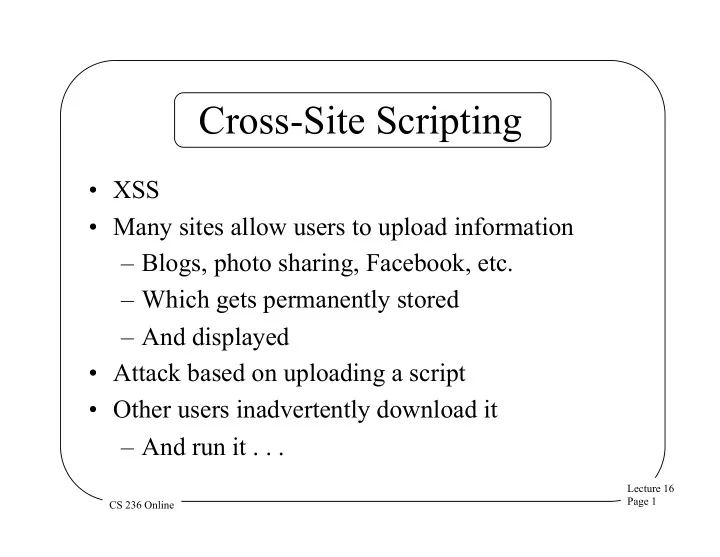

Cross-Site Scripting • XSS • Many sites allow users to upload information – Blogs, photo sharing, Facebook, etc. – Which gets permanently stored – And displayed • Attack based on uploading a script • Other users inadvertently download it – And run it . . . Lecture 16 Page 1 CS 236 Online
The Effect of XSS • Arbitrary malicious script executes on user’s machine • In context of his web browser – At best, runs with privileges of the site storing the script – Often likely to run at full user privileges Lecture 16 Page 2 CS 236 Online
Non-Persistent XSS • Embed a small script in a link pointing to a legitimate web page • Following the link causes part of it to be echoed back to the user’s browser • Where it gets executed as a script • Never permanently stored at the server Lecture 16 Page 3 CS 236 Online
Persistent XSS • Upload of data to a web site that stores it permanently • Generally in a database somewhere • When other users request the associated web page, • They get the bad script Lecture 16 Page 4 CS 236 Online
Some Examples • Word Press bug allowed XSS (2016) • Other XSS vulnerabilities discovered on sites run by Yahoo, Symantec, PayPal, Facebook, LinkedIn, Adobe, Apple App Store, Google Gmail, Fortinet, the Scientology website, thousands of others • D-Link router flaw exploitable through XSS Lecture 16 Page 5 CS 236 Online
Why Is XSS Common? • Use of scripting languages widespread – For legitimate purposes • Most users leave them enabled in their browsers • Sites allowing user upload are very popular • Only a question of getting user to run your script Lecture 16 Page 6 CS 236 Online
Typical Effects of XSS Attack • Most commonly used to steal personal information – That is available to legit web site – User IDs, passwords, credit card numbers, etc. • Such information often stored in cookies at client side Lecture 16 Page 7 CS 236 Online
Solution Approaches • Don’t allow uploading of anything • Don’t allow uploading of scripts • Provide some form of protection in browser Lecture 16 Page 8 CS 236 Online
Disallowing Data Uploading • Does your web site really need to allow users to upload stuff? • Even if it does, must you show it to other users? • If not, just don’t take any user input • Problem : Not possible for many important web sites Lecture 16 Page 9 CS 236 Online
Don’t Allow Script Uploading • A no-brainer for most sites – Few web sites want users to upload scripts, after all • So validate user input to detect and remove scripts • Problem : Rich forms of data encoding make it hard to detect all scripts • Good tools can make it easier Lecture 16 Page 10 CS 236 Online
Protect the User’s Web Browser • Basically, the same solutions as for any form of protecting from malicious scripts • With the same problems: – Best solutions cripple functionality Lecture 16 Page 11 CS 236 Online
Cross-Site Request Forgery • CSRF • Works the other way around • An authenticated and trusted user attacks a web server – Usually someone posing as that user • Generally to fool server into believing that the trusted user made a request Lecture 16 Page 12 CS 236 Online
CSRF in Action • Attacker puts link to (say) a bank on his web page • Unsuspecting user clicks on the link • His authentication cookie goes with the HTTP request – Since it’s for the proper domain • Bank authenticates him and transfers his funds to the attacker Lecture 16 Page 13 CS 236 Online
Issues for CSRF Attacks • Not always possible or easy • Attacks sites that don’t check referrer header – Indicating that request came from another web page • Attacked site must allow use of web page to allow something useful (e.g., bank withdrawal) • Must not require secrets from user • Victim must click link on attacker’s web site • And attacker doesn’t see responses Lecture 16 Page 14 CS 236 Online
CSRF In the Wild • CSRF possibility in Verizon Mobile App API • eBay CSRF problem in Magneto e- commerce system • A CSRF-based pharming toolkit that attacked wireless routers discovered • CSRF problem in Arris cable modems Lecture 16 Page 15 CS 236 Online
Recommend
More recommend